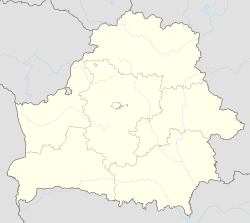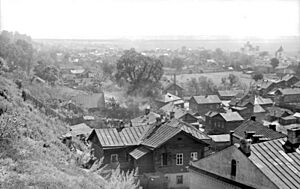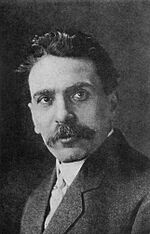Mogilev facts for kids
Quick facts for kids
Mogilev
Магілёў • Могилёв
Mahilyow
|
|||
|---|---|---|---|
| Belarusian transcription(s) | |||
| • BGN/PCGN | Mahilyow | ||
| • Official | Mahiliow | ||
| • Scholarly | Mahilëŭ | ||
| • ALA-LC | Mahili͡oŭ | ||
| • British | Mahilëw | ||
| • Łacinka | Mahiloŭ | ||
 |
|||
|
|||
| Country | Belarus | ||
| Region | Mogilev Region | ||
| Founded | 1267 | ||
| Area | |||
| • Total | 118.50 km2 (45.75 sq mi) | ||
| Elevation | 192 m (630 ft) | ||
| Population
(2024)
|
|||
| • Total | 353,110 | ||
| • Density | 2,979.83/km2 (7,717.7/sq mi) | ||
| Time zone | UTC+3 (MSK) | ||
| Postal code |
212 001
|
||
| Area code(s) | +375 222 | ||
| License plate | 6 | ||
| Website | City's executive committee's official website: http://mogilev.gov.by/ | ||
Mogilev (also called Mahilyow) is a large city in eastern Belarus. It sits on the Dnieper River. The city is about 76 kilometers (47 miles) from the border with Russia.
As of 2024, Mogilev has a population of 353,110 people. It is the third-largest city in Belarus. Mogilev is also the main city of the Mogilev Region.
Contents
Mogilev's Past: A Journey Through Time
Early Beginnings and Growth
The city of Mogilev was first mentioned in history books in the year 1267. For a long time, starting in the 14th century, it was part of the Grand Duchy of Lithuania. Later, after the Union of Lublin in 1569, it became part of the Polish–Lithuanian Commonwealth. During the 16th and 17th centuries, Mogilev grew into an important trading hub. It was a key stop on major trade routes going east-west and north-south.
In 1577, the Polish King Stefan Batory gave Mogilev special "city rights." These rights, known as Magdeburg law, gave the city more freedom to govern itself.
Wars and Changes
In 1654, during a war between Russia and Poland, the people of Mogilev made a deal with the Russians. They agreed to surrender peacefully if Jewish residents were expelled. However, instead of expelling them, Russian troops killed many Jewish people. The city was also attacked by the Lithuanian army in 1655 and 1660. In 1661, local people started an uprising against Russian rule.
Later, in 1708, during the Great Northern War, Peter the Great's forces set the city on fire. In 1772, after parts of Poland were divided up, Mogilev became part of the Russian Empire. It then became the main city of the Mogilev Governorate.
World Wars and Soviet Times
During World War I, from 1915 to 1917, the headquarters of the Russian Imperial Army was located in Mogilev. Even the Tsar, Nicholas II, spent a lot of time there as the army's leader.
After the Russian Revolution in 1918, Germany briefly took over the city. In 1919, Soviet Russia took control, and Mogilev became part of the Byelorussian SSR. Before World War II, many Jewish people lived in Mogilev. In 1897, over half of the city's population was Jewish.
In 1938, leaders in Soviet Belarus thought about moving the capital from Minsk to Mogilev. This was because Minsk was too close to the border with Poland at the time. A large building, now the Mogilev City Council, was built to be the government building.
During World War II, German forces took over Mogilev in July 1941. The city remained under German control until June 1944. During this time, Jewish people in Mogilev were forced into a ghetto. They were then systematically killed by German police and soldiers. In October 1941, Heinrich Himmler, a high-ranking Nazi official, even watched some of these killings.
In 1944, the Red Army freed Mogilev. The city was badly damaged. After the war, Mogilev became a labor camp for German prisoners of war. Since Belarus became an independent country in 1991, Mogilev has remained one of its most important cities.
Faith and Religion in Mogilev
Mogilev was once the main center for the Catholic Church in the region. In 1991, it joined with the Minsk-Mohilev Archdiocese. The city is still an important center for the Russian Orthodox Church. The St. Nicholas Monastery Complex is a notable religious site here.
Mogilev's Economy and Industries
After World War II, Mogilev became a major industrial center. Many large factories were built. These factories made steel, cranes, cars, and tractors. There was also a big chemical plant.
By the 1950s, making leather was a main industry. Mogilev was also a key place for trading grain, leather, salt, sugar, fish, and wood. The city has a large inland port on the Dnieper river. It also has an airport. Today, Mogilev is one of Belarus's most important economic and industrial cities.
City Landmarks and Architecture
Mogilev has many interesting buildings and places to see.
Historic Town Hall
The city's most famous landmark is the old town hall, called the Ratuša. It was built in the late 1600s when Mogilev was part of the Polish-Lithuanian Commonwealth. The town hall's tall tower was damaged in wars. It was taken down in 1957 but rebuilt to look like its original form in 2008.
St. Stanisław's Cathedral
Another important building is the six-pillared St. Stanisław's Cathedral. It was built in the beautiful Baroque style between 1738 and 1752. The cathedral is known for its amazing paintings inside.
St. Nicholas Convent
The convent of St. Nicholas has a grand cathedral from 1668. It still has its original iconostasis (a wall of icons), bell tower, walls, and gates. This convent is being considered to become a UNESCO World Heritage site.
Other Notable Sights
Other interesting places include the archbishop's palace and a memorial arch, both from the 1780s. There is also a huge theater that mixes Neo-Renaissance and Russian Revival styles. In Polykovichi, a part of Mogilev, there is a very tall TV mast. It is 350 meters (1,148 feet) high, making it one of the tallest structures in Belarus.
Climate and Geography
Mogilev has a climate with warm summers and cold winters. This type of climate is called a humid continental climate.
| Climate data for Mogilev | |||||||||||||
|---|---|---|---|---|---|---|---|---|---|---|---|---|---|
| Month | Jan | Feb | Mar | Apr | May | Jun | Jul | Aug | Sep | Oct | Nov | Dec | Year |
| Record high °C (°F) | 9.8 (49.6) |
12.9 (55.2) |
19.3 (66.7) |
29.1 (84.4) |
30.8 (87.4) |
32.6 (90.7) |
34.3 (93.7) |
36.8 (98.2) |
30.6 (87.1) |
25.5 (77.9) |
14.5 (58.1) |
10.9 (51.6) |
36.8 (98.2) |
| Mean daily maximum °C (°F) | −3.0 (26.6) |
−2.5 (27.5) |
3.0 (37.4) |
12.0 (53.6) |
18.6 (65.5) |
21.5 (70.7) |
23.6 (74.5) |
22.7 (72.9) |
16.7 (62.1) |
9.9 (49.8) |
2.3 (36.1) |
−2.0 (28.4) |
10.2 (50.4) |
| Daily mean °C (°F) | −5.3 (22.5) |
−5.5 (22.1) |
−0.8 (30.6) |
6.7 (44.1) |
12.9 (55.2) |
16.1 (61.0) |
18.1 (64.6) |
17.0 (62.6) |
11.6 (52.9) |
6.0 (42.8) |
−0.1 (31.8) |
−4.2 (24.4) |
6.0 (42.8) |
| Mean daily minimum °C (°F) | −7.8 (18.0) |
−8.5 (16.7) |
−4.2 (24.4) |
2.0 (35.6) |
7.3 (45.1) |
10.8 (51.4) |
12.7 (54.9) |
11.6 (52.9) |
7.1 (44.8) |
2.6 (36.7) |
−2.3 (27.9) |
−6.6 (20.1) |
2.1 (35.8) |
| Record low °C (°F) | −37.3 (−35.1) |
−34.7 (−30.5) |
−35.0 (−31.0) |
−17.7 (0.1) |
−4.4 (24.1) |
−0.7 (30.7) |
3.0 (37.4) |
0.9 (33.6) |
−4.8 (23.4) |
−14.8 (5.4) |
−23.5 (−10.3) |
−33.4 (−28.1) |
−37.3 (−35.1) |
| Average precipitation mm (inches) | 39 (1.5) |
34 (1.3) |
39 (1.5) |
41 (1.6) |
53 (2.1) |
75 (3.0) |
81 (3.2) |
65 (2.6) |
55 (2.2) |
54 (2.1) |
45 (1.8) |
41 (1.6) |
622 (24.5) |
| Average rainy days | 8 | 7 | 9 | 12 | 15 | 17 | 15 | 13 | 14 | 15 | 14 | 10 | 149 |
| Average snowy days | 21 | 20 | 13 | 4 | 0.2 | 0 | 0 | 0 | 0.1 | 3 | 12 | 20 | 93 |
| Average relative humidity (%) | 87 | 85 | 80 | 72 | 69 | 74 | 74 | 75 | 80 | 84 | 89 | 89 | 80 |
| Source: Pogoda.ru.net | |||||||||||||
Famous People from Mogilev
Many notable people have come from Mogilev, including:
- Rita Achkina, a cross-country skier.
- Matest M. Agrest, an ethnologist and mathematician.
- Modest Altschuler, an orchestra conductor.
- Alyona Lanskaya, a singer.
- Joseph Lookstein, a Rabbi and university president.
- Leonid Isaakovich Mandelshtam, a physicist.
- David Pinski, a Yiddish playwright.
- Lev Polugaevsky, an International Chess Grandmaster.
- Otto Schmidt, a scientist and academician.
- Issai Schur, a mathematician.
- Spiridon Sobol, a Belarusian printer who published the first ABC-book in Belarus.
Sports in Mogilev
Mogilev is home to several sports teams:
- Football: FC Torpedo Mogilev, FC Dnepr Mogilev, ZhFC Dnepr Mogilev, and Nadezhda Mogilev.
- Hockey: HK Mogilev.
- Volleyball: Mogilev Lions and Kommunalnik.
- Handball: Masheka.
- Basketball: BC Borisfen.
Sister Cities Around the World
Mogilev has "sister city" relationships with many cities across the globe. This means they share cultural and educational ties.
 Al Rayyan, Qatar
Al Rayyan, Qatar Bursa, Turkey
Bursa, Turkey Changsha, China
Changsha, China Eisenach, Germany
Eisenach, Germany Gabrovo, Bulgaria
Gabrovo, Bulgaria Kerch, Ukraine
Kerch, Ukraine Kragujevac, Serbia
Kragujevac, Serbia Mykolaiv, Ukraine
Mykolaiv, Ukraine Nanjing, China
Nanjing, China Penza, Russia
Penza, Russia Sokolinaya Gora (Moscow), Russia
Sokolinaya Gora (Moscow), Russia Sumgait, Azerbaijan
Sumgait, Azerbaijan Tabriz, Iran
Tabriz, Iran Tula, Russia
Tula, Russia Villeurbanne, France
Villeurbanne, France Wittenberg, Germany
Wittenberg, Germany Yuzhne, Ukraine
Yuzhne, Ukraine Zhengzhou, China
Zhengzhou, China Zvenigorod, Russia
Zvenigorod, Russia
Images for kids
See also
 In Spanish: Maguilov para niños
In Spanish: Maguilov para niños















